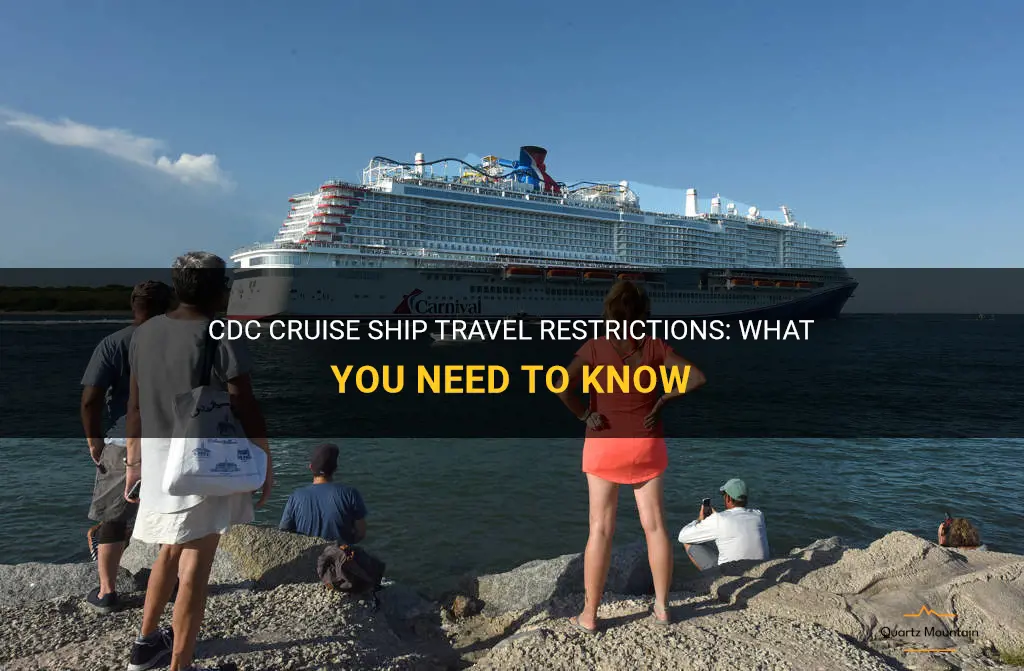
Are you dreaming of setting sail on a luxurious cruise ship, exploring exotic destinations and indulging in first-class amenities? While the idea of a cruise vacation may sound enticing, it's important to be aware of any travel restrictions that may be in place. This rings especially true with the recent outbreak of infectious diseases like COVID-19. The Centers for Disease Control and Prevention (CDC) has implemented strict guidelines for cruise ship travel to ensure the safety and well-being of both passengers and crew members. So, before you embark on your next cruise adventure, let's take a closer look at these restrictions and what they mean for your travel plans.
What You'll Learn
- What are the current travel restrictions for cruise ships imposed by the CDC?
- How long have these cruise ship travel restrictions been in place?
- Are there any exemptions to the CDC's cruise ship travel restrictions?
- What specific measures or protocols must cruise ships implement to resume operations?
- When does the CDC plan to reassess or potentially lift these cruise ship travel restrictions?

What are the current travel restrictions for cruise ships imposed by the CDC?
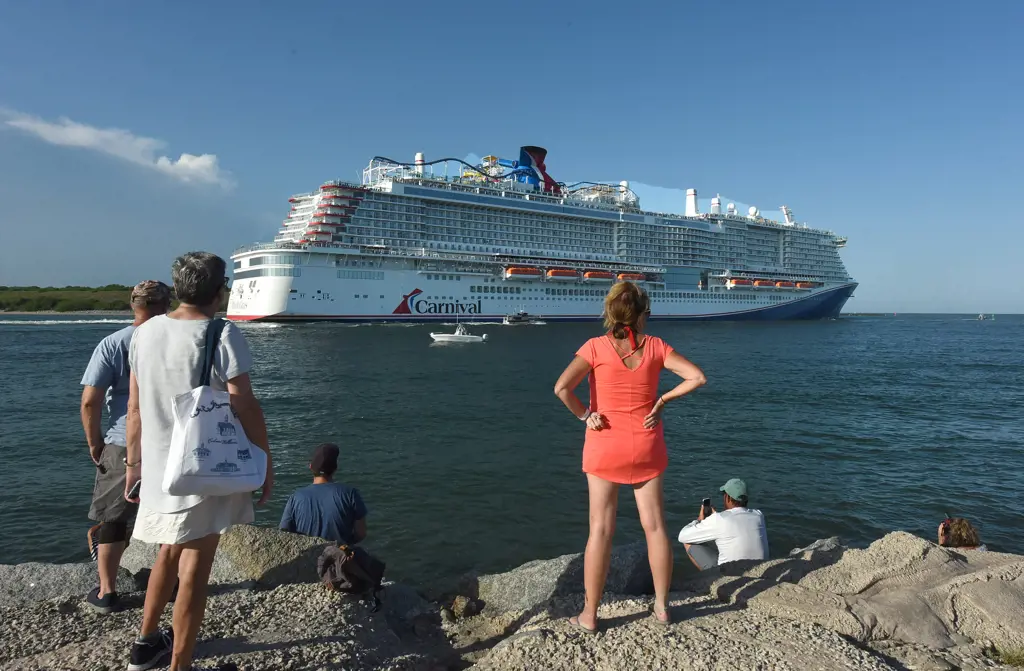
Currently, the Centers for Disease Control and Prevention (CDC) has implemented several travel restrictions for cruise ships due to the ongoing COVID-19 pandemic. These restrictions are aimed at preventing the spread of the virus and protecting the health and safety of passengers and crew members.
One of the main restrictions imposed by the CDC is the issuance of a "no-sail order" for cruise ships operating in U.S. waters. This order, which has been extended multiple times, prohibits cruise ships with a capacity of 250 or more passengers from sailing in U.S. waters until certain conditions are met. These conditions include the implementation of additional health and safety measures to prevent COVID-19 transmission on board and the establishment of agreements with healthcare facilities for the medical treatment of any passengers or crew members who may become infected with the virus.
In addition to the no-sail order, the CDC has also released a framework for the resumption of cruise ship operations. This framework outlines a phased approach to resuming cruise ship operations, with specific requirements and protocols that cruise lines must follow to ensure the safety of passengers and crew members. These requirements include testing all passengers and crew members for COVID-19 before embarkation and disembarkation, implementing enhanced sanitation measures on board, and establishing comprehensive plans for managing and responding to COVID-19 cases on board.
Furthermore, the CDC has issued several specific recommendations for cruise ship travelers. These recommendations include avoiding travel on cruise ships, especially for individuals who are at higher risk for severe illness from COVID-19, such as older adults and people with underlying medical conditions. The CDC also advises against using commercial transportation, such as buses and trains, to reach a cruise ship or to return home after disembarking. Instead, the CDC recommends using personal vehicles or private transportation arranged by the cruise line to minimize the risk of exposure to the virus.
It is important to note that the travel restrictions imposed by the CDC are subject to change based on the evolving situation with the COVID-19 pandemic. Cruise lines are working closely with the CDC and other relevant authorities to meet the requirements and guidelines for resuming operations. Passengers are advised to closely follow updates from the CDC and their chosen cruise line for the latest information on travel restrictions and safety protocols.
Exploring the Latest Bihar Travel Restrictions: What You Need to Know
You may want to see also

How long have these cruise ship travel restrictions been in place?
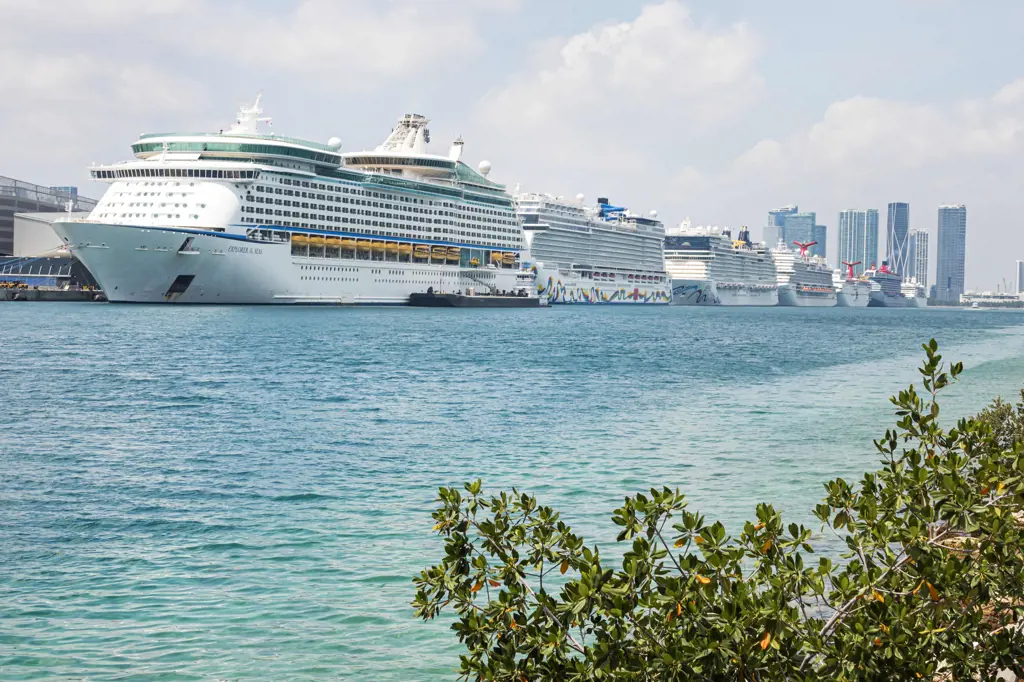
Cruise ship travel restrictions have been in place for more than a year now. Since the onset of the COVID-19 pandemic in early 2020, many countries have implemented strict measures to control the spread of the virus, including restricting the operation of cruise ships.
The first major wave of restrictions came in early 2020 when several cruise ships experienced outbreaks of COVID-19 on board. These outbreaks led to widespread transmission of the virus among passengers and crew members, resulting in multiple deaths and increasing concerns about the safety of cruise ship travel.
To prevent further spread of the virus, many countries closed their ports to cruise ships and implemented travel bans or stringent quarantine measures for passengers and crew members. These restrictions were initially seen as temporary measures to contain the virus, but as the pandemic continued to worsen, the restrictions were extended and sometimes tightened.
In some cases, cruise ships were allowed to dock at ports but were not allowed to disembark passengers, or passengers were required to undergo mandatory quarantine before being allowed to enter the country. These measures were aimed at protecting local populations from potential virus transmissions from cruise ship passengers or crew members.
The duration of the cruise ship travel restrictions has varied from country to country and has been heavily influenced by the local COVID-19 situation. Some countries have gradually eased their restrictions as the number of COVID-19 cases declined, while others have maintained strict measures due to ongoing outbreaks or concerns about new variants of the virus.
International health organizations and cruise industry associations have been working together to develop strict health and safety protocols for the resumption of cruise ship operations. These protocols include increased testing, enhanced sanitation measures, social distancing, and improved medical facilities on board.
Despite the efforts to implement these safety measures, the return of cruise ship travel to pre-pandemic levels is likely to be a gradual process. The cruise industry has been significantly impacted by the pandemic, with many cruise lines suspending operations and enduring substantial financial losses.
In conclusion, cruise ship travel restrictions have been in place for over a year due to the COVID-19 pandemic. These restrictions have been implemented to prevent the spread of the virus and protect the health and safety of passengers, crew members, and local populations. The duration of these restrictions has varied depending on the local COVID-19 situation, and the industry is working on implementing strict protocols to resume operations safely.
Understanding Allegiant Travel's Current Restrictions: What You Need to Know
You may want to see also

Are there any exemptions to the CDC's cruise ship travel restrictions?
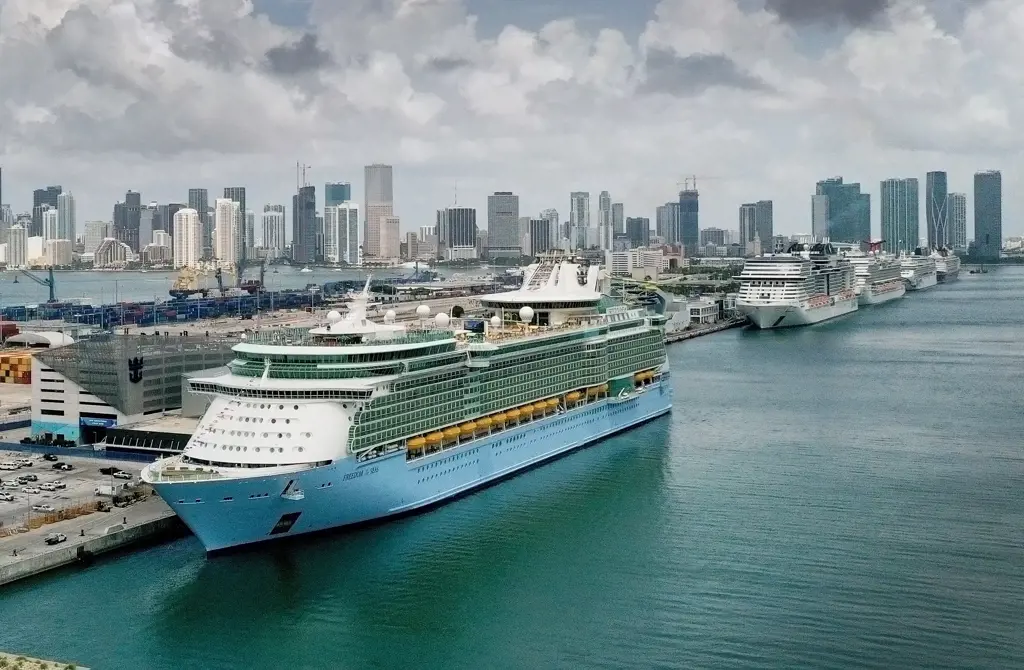
The Centers for Disease Control and Prevention (CDC) has implemented travel restrictions for cruise ships, aiming to prevent the spread of COVID-19. These guidelines have had a significant impact on the cruise industry, with numerous cancellations and suspensions of operations. However, there are some exemptions to the CDC's cruise ship travel restrictions.
One of the exemptions is for ships that are conducting humanitarian or repatriation voyages. This means that if a cruise ship is involved in activities such as transporting medical supplies or evacuating stranded individuals, it may be allowed to operate even during the travel restrictions. These exemptions are granted on a case-by-case basis, and the cruise lines must demonstrate that they have appropriate health and safety protocols in place.
Another exemption to the CDC's cruise ship travel restrictions is for ships that are engaged in non-passenger operations. This includes activities such as maintenance, training, or provisioning. Cruise lines may need to move their ships from one port to another for these purposes, and they can do so even during the travel restrictions. However, it's important to note that these non-passenger operations must be essential and necessary for the safe operation of the ship.
Additionally, the CDC has introduced a phased approach to resuming cruise ship operations, called the Framework for Conditional Sailing Order. Under this framework, cruise lines can apply for a Conditional Sailing Certificate (CSC) if they meet specific requirements and protocols to ensure the safety of passengers and crew. If a cruise line receives a CSC, it is exempt from the travel restrictions imposed by the CDC. The cruise line must conduct simulated voyages to demonstrate their ability to mitigate the risk of COVID-19 transmission.
It's essential to understand that these exemptions and the phased approach to resuming operations are subject to change as the situation regarding COVID-19 evolves. The CDC will continue to evaluate new information and update their guidelines accordingly. Cruise lines and passengers should closely monitor the CDC's website and official announcements for the most up-to-date information on exemptions and travel restrictions.
In conclusion, while the CDC's cruise ship travel restrictions have significantly impacted the cruise industry, there are exemptions to these restrictions. Ships engaged in humanitarian or repatriation voyages, non-passenger operations, or those that have received a Conditional Sailing Certificate are exempt from the travel restrictions. However, it's crucial to stay informed about any changes or updates to these exemptions as the COVID-19 situation evolves.
Navigating the Riverside County Travel Restrictions: What You Need to Know
You may want to see also

What specific measures or protocols must cruise ships implement to resume operations?
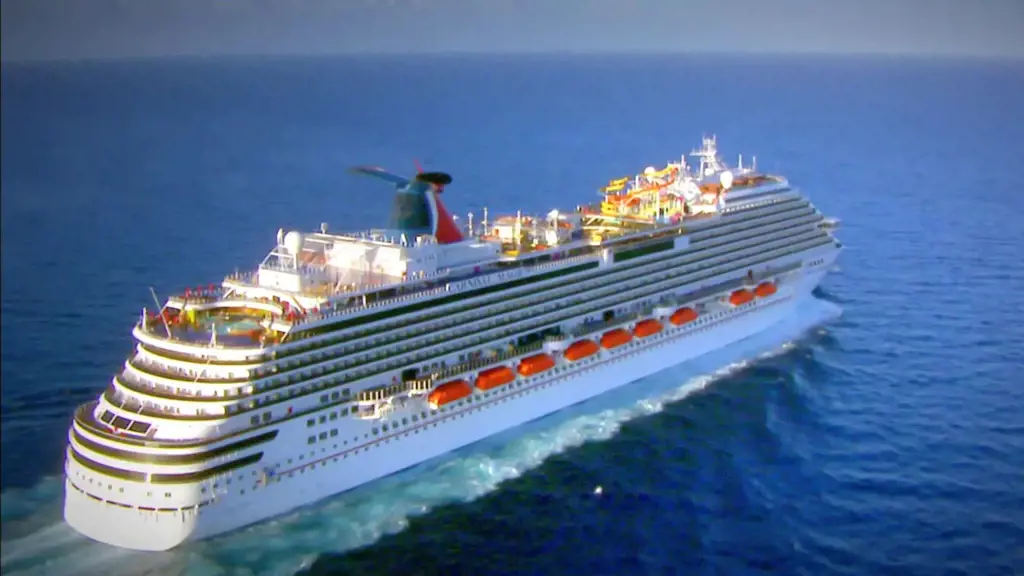
Cruise ships have been greatly affected by the COVID-19 pandemic, with many ships being forced to suspend their operations since early 2020. As the world slowly starts to recover, cruise ship companies are eagerly awaiting the opportunity to resume their operations. However, in order to ensure the safety of passengers and crew members, cruise ships must implement specific measures and protocols.
One of the key measures that cruise ships must implement is enhanced cleaning and sanitization. Cruise ships are known for their large number of passengers and crew members in a confined space, which makes them vulnerable to the spread of infectious diseases. To address this, cruise ship companies must increase the frequency and intensity of their cleaning and sanitization procedures. This includes disinfecting frequently-touched surfaces such as handrails, elevator buttons, and door handles, as well as implementing regular deep cleaning protocols.
Social distancing measures must also be implemented on cruise ships. This includes reducing the overall capacity of the ship to allow for greater spacing between passengers and crew members. Common areas such as dining rooms, lounges, and entertainment venues must be reconfigured to ensure a safe distance between individuals. Additionally, cruise ships may need to implement staggered boarding and disembarkation times to minimize crowding at ports of call.
The implementation of health screening protocols is another crucial measure. Cruise ship companies must develop and enforce strict health screening measures for all passengers and crew members. This may include temperature checks, COVID-19 testing prior to boarding, and health questionnaires. Those who show symptoms or test positive for COVID-19 should be denied boarding and provided with appropriate medical care.
Furthermore, cruise ships must enhance their medical facilities and capabilities. Onboard medical teams must be adequately trained and equipped to handle potential COVID-19 cases. Cruise ships should have isolation areas and quarantine protocols in place to prevent the spread of infectious diseases. Access to medical care and medications must also be made readily available for all passengers and crew members.
Lastly, cruise ship companies must have contingency plans in place to handle any potential outbreaks or emergencies. These plans should outline the steps to be taken in case of a suspected or confirmed case of COVID-19 onboard, including communication with passengers, coordination with local health authorities, and proper quarantine procedures. Additionally, cruise ships must have protocols in place for the safe evacuation and transportation of passengers in case of emergency situations.
In conclusion, in order to resume their operations safely, cruise ships must implement a range of measures and protocols to mitigate the risk of COVID-19 transmission. Enhanced cleaning and sanitization, social distancing measures, health screening protocols, improved medical facilities, and contingency plans are necessary to ensure the safety and well-being of passengers and crew members. By implementing these measures, cruise ship companies can regain the trust of travelers and resume their operations in a responsible manner.
Exploring England: An Update on Current Travel Restrictions
You may want to see also

When does the CDC plan to reassess or potentially lift these cruise ship travel restrictions?
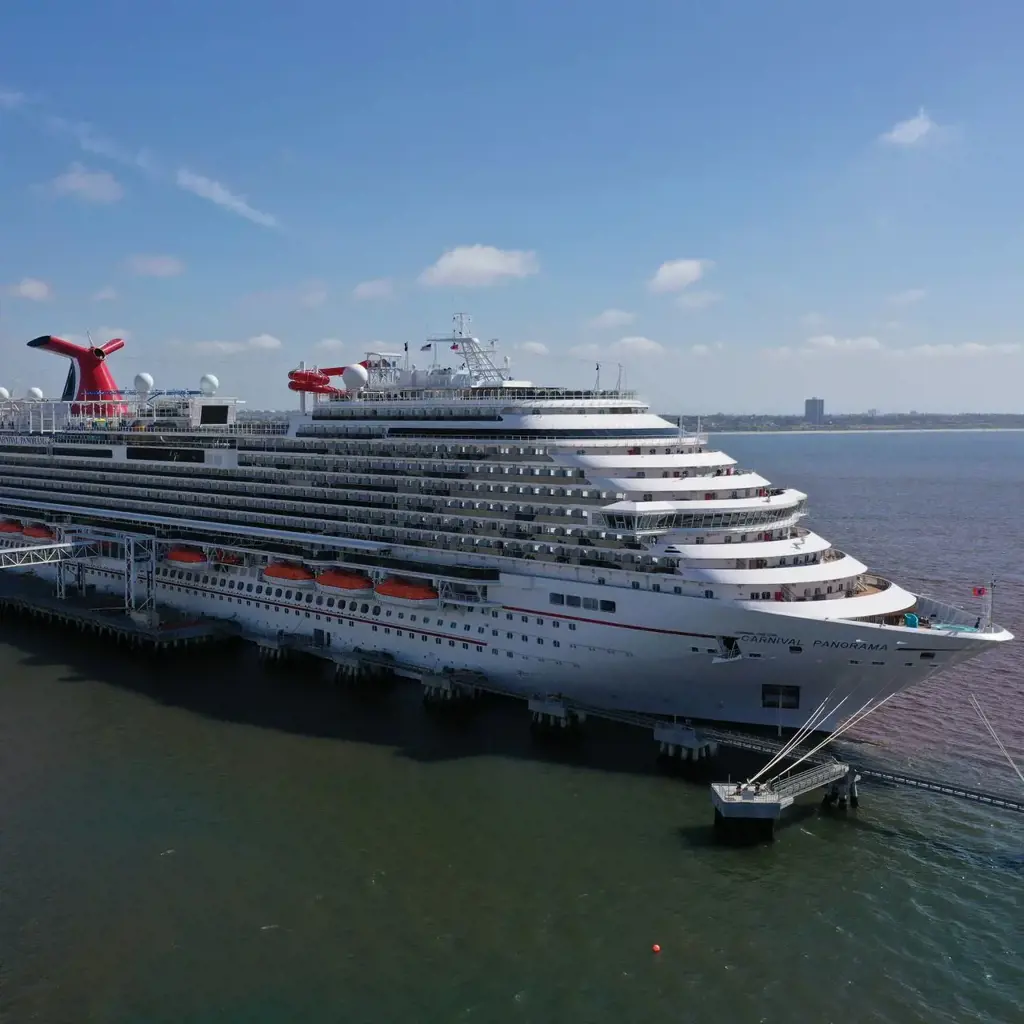
The Centers for Disease Control and Prevention (CDC) has imposed strict restrictions on cruise ship travel due to the ongoing COVID-19 pandemic. These restrictions have been put in place to prevent further spread of the virus and protect the health and safety of passengers and crew members.
As of now, the CDC has not provided a specific timeline for when these travel restrictions will be reassessed or lifted. The current restrictions are in place until November 1, 2021, but they may be extended or modified based on the evolving situation with the pandemic.
The CDC regularly evaluates the risks associated with cruise ship travel and monitors the global epidemiological situation. They consider factors such as the number of cases in destinations where cruise ships operate, the impact of new variants of the virus, and the ability of cruise ships to implement and maintain effective mitigation measures.
Before lifting the restrictions, the CDC will likely assess various factors, including the vaccination rates among passengers and crew members, the ability of cruise lines to implement safety protocols, and the overall control of COVID-19 transmission on board.
It's important to note that the CDC's decisions are primarily driven by public health considerations. Therefore, the lifting of travel restrictions will depend on the CDC's assessment of the risks involved and their confidence in the cruise industry's ability to operate safely.
In the meantime, the CDC continues to recommend avoiding cruise ship travel, especially for individuals who are not fully vaccinated or who have underlying health conditions. They urge individuals to follow their guidance on necessary precautions and to monitor the CDC's website for updates on travel restrictions.
As the situation evolves and vaccination rates increase, there may be a gradual relaxation of the restrictions. However, it is crucial to prioritize public health and safety to prevent any potential outbreaks on cruise ships.
Ultimately, the CDC will reassess and potentially lift these cruise ship travel restrictions based on the latest scientific evidence and the overall control of COVID-19 both domestically and internationally. Until then, it is important for individuals to stay informed and follow the guidance provided by public health authorities.
Understanding Israel's Travel Restrictions for U.S. Citizens: What You Need to Know
You may want to see also
Frequently asked questions
The current CDC cruise ship travel restrictions state that all cruise ships in U.S. waters are under a No Sail Order, which prohibits cruise ships with a capacity of 250 or more passengers from operating. This order is in effect until further notice and is aimed at preventing the spread of COVID-19 on cruise ships.
Cruise ships can resume operations once they meet specific requirements outlined by the CDC and obtain a conditional sailing certificate. These requirements include conducting simulated voyages to test COVID-19 mitigation measures, implementing comprehensive health and safety protocols, and achieving a low threshold of COVID-19 cases on board. The timeline for cruise ships to resume operations varies depending on each cruise line's readiness and ability to meet these requirements.
There are limited exemptions to the CDC cruise ship travel restrictions. Small cruise ships with a capacity of less than 250 passengers are allowed to operate, but they must follow strict health and safety guidelines. Additionally, some cruise lines have obtained approval for limited sailings by implementing rigorous health protocols and testing strategies. These exemptions are subject to change based on the current COVID-19 situation and CDC guidelines.







